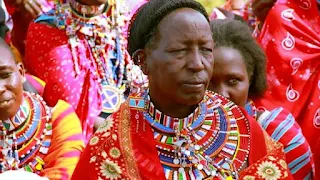Wearing gorgeous Maasai beaded wedding collars, bead working has a rich history among Maasai women on their wedding day.
 |
| Bead working has a rich history among Maasai women. |
The Maasai community in East Africa is renowned for its unique and colorful jewelry, particularly among its women. This jewelry carries great cultural and symbolic significance and plays a crucial role in their traditions, ceremonies, and daily lives. Maasai brides wear an elaborate beaded wedding collar or inkarewa on her wedding day. African jewelry, such as the inkarewa is created from a wide variety of materials, including beads, seeds, woods, gourds, bone, ivory, copper, and brass.
Maasai Wedding Jewelry
Generally, African jewelry is made from materials that are immediately available to the artist in their community. White beads created from clay, shells, ivory, or bone. Black and blue beads fashioned from iron, charcoal, seeds, clay, or animal horns. Red beads came from seeds, woods, gourds, bone, ivory, copper, or brass.
The style of African jewelry is as wide and varied as the continent of Africa. African jewelry is created for more than personal adornment by the wearer; it also designates rank, class, affluence, rites of passage and tribal association. Certain kinds of jewelry are worn only by men or by women.
Bead working has a rich history among the Maasai women. The Maasai communicate their identity and position in Maasai society through body decorations and body painting. Maasai women wear elaborate ensembles of beaded clothing and adornment, including necklaces and ear ornaments.
Marriage in traditional Maasai tribes is an arranged event. The elders arrange marriages and brides are married off for a dowry of cattle which is the measure of wealth in Maasai society.
In traditional African jewelry, bones are commonly used to make jewelry. Maasai cultures throughout Africa have passed down the process of bone carving from generation to generation with each elaborate beaded wedding collar or inkarewa using bone carving as a handmade art.
The bride wears her marriage collar or inkarewa on her wedding day. The Maasai inkarewa is created with a sense of honor and fine artistry since the bridal collar is thought to be a reflection on the bride. Similarly, in the United States a brides wedding dress sets the tone for the entire wedding party.
Maasai women inkarewa wedding collars are worn on the brides wedding day and is one of the most important piece of wedding day attire. African jewelry such as the inkarewa is created from a wide variety of materials, including beads, seeds, woods, gourds, bone, ivory, copper, and brass.
Maasai women are known for their distinct and vibrant jewelry, which holds cultural and symbolic significance within the Maasai community in East Africa. Jewelry plays an essential role in their traditions, ceremonies, and daily life.
Maasai women also wear beaded waistbands and body beads. These beads are worn around the waist and sometimes extend across the stomach and hips. The waistbands are worn as a symbol of femininity and beauty, and they may make rhythmic sounds as the women dance.
- African Country Names Your Saying Wrong
- What do Waist Beads Symbolize in Africa?
- About African Healers and Witchdoctors
- Hurricanes are Angry African Ancestors
- Highest Temperature and Lowest Temperature in Africa
- About African Night Running



























